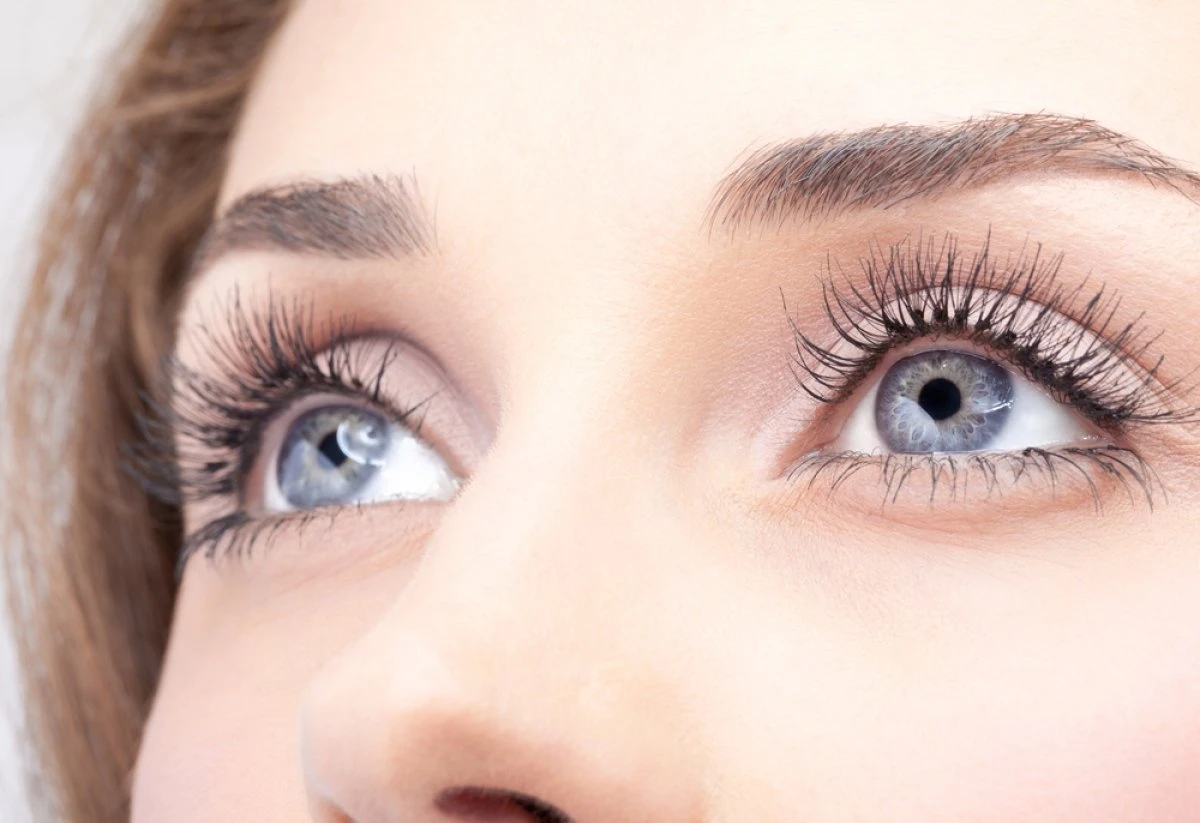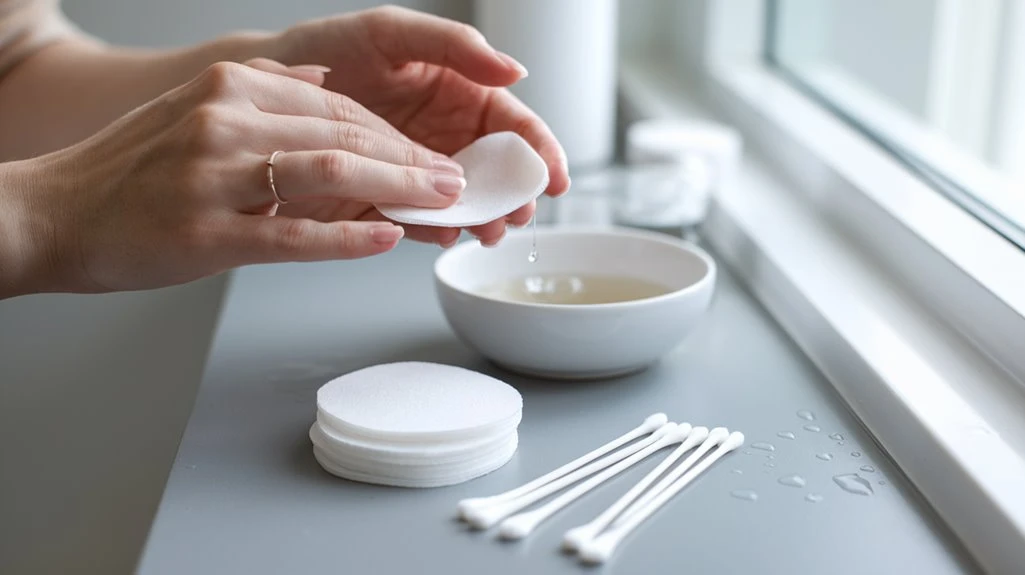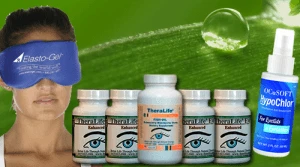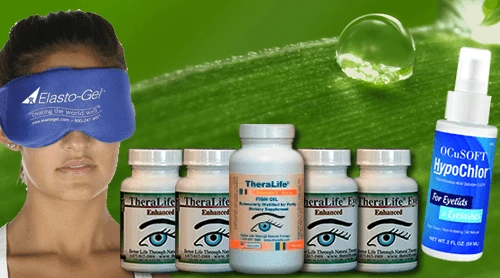To effectively clean your eyelids for blepharitis, begin by gathering essential items such as a clean washcloth, a non-scented cleanser, and cotton pads. Start by washing your hands thoroughly to maintain hygiene. Next, prepare a warm compress at around 40°C and gently place it over your closed eyelids for 5-10 minutes, which helps in loosening any debris. After this, gently clean along the eyelid margins with a moistened pad, rinse with cool water, and softly pat the area dry. Apply any prescribed medications as directed for optimal results.
Incorporating TheraLife’s products can enhance this routine, as they offer specialized treatments for blepharitis and provide relief from associated symptoms. TheraLife’s offerings are designed to support eye health and comfort, particularly for those experiencing dry eyes and related conditions. By using TheraLife’s products, customers can benefit from a comprehensive approach to managing blepharitis, ensuring eyes remain clean, healthy, and irritation-free.
Best Blepharitis Treatment From TheraLife- When Drops Don’t Work.
Key Takeaways
- Wash your hands thoroughly before starting to reduce the risk of eye infection.
- Apply a warm compress to closed eyelids for 5–10 minutes to loosen debris and unclog glands.
- Use a clean, moistened cotton pad or swab with mild cleanser to gently wipe along the eyelid margins.
- Avoid rubbing or scrubbing; instead, gently pat the eyelids dry with a soft, lint-free towel.
- Follow your doctor’s instructions for applying prescribed medications to the eyelid margins after cleaning.
Gather Necessary Supplies
To clean your eyelids for blepharitis, you’ll need several essential supplies: a clean washcloth or cotton pads, mild non-scented cleanser (such as diluted baby shampoo or a commercially available eyelid scrub), a small bowl of warm water, and clean hands. Each item supports effective eyelid hygiene and ideal cleaning techniques. Select a non-abrasive washcloth or sterile cotton pads to minimize mechanical trauma to the eyelid margin. For your cleanser, choose one formulated for sensitive periocular tissues to prevent irritation. The warm water is necessary to dilute the cleanser and to maintain comfort during the procedure. Organizing these supplies before starting improves procedural efficiency and reduces the risk of contamination. Prioritizing proper materials is a foundational step for successful eyelid hygiene and symptom management. Additionally, consider using products with hypochlorous acid for gentle and effective cleansing of eyelids and eyelashes.
Wash Your Hands Thoroughly
After collecting your cleaning supplies, focus on hand hygiene before you touch the periocular area. Implementing meticulous hand hygiene is essential for infection prevention, especially when managing blepharitis. Wash your hands with a medical-grade or antibacterial soap and water for at least 20 seconds. Scrub all surfaces, including the dorsum, palms, interdigital spaces, and subungual regions. Rinse thoroughly and dry with a lint-free towel. This step reduces microbial load and the risk of inoculating the eyelid margin with pathogenic bacteria. Consistent eyelid hygiene is crucial for controlling blepharitis symptoms and preventing bacterial overgrowth.
Here’s why this matters:
| Risk | Consequence | Prevention |
|---|---|---|
| Poor Hand Hygiene | Spread of Infection | Decreased risk |
| Bacterial Transfer | Worsened Blepharitis | Symptom relief |
| Neglect | Treatment Failure | Ideal outcomes |
Adhering to strict hand hygiene supports the integrity of your eyelid cleansing routine.
Prepare a Warm Compress
Many blepharitis management protocols recommend a warm compress as the next vital step. To enhance eyelid hygiene, you need to prepare the compress correctly using medical best practices.
Start by selecting a clean washcloth and confirming the water temperature is neither too hot nor too cold—ideally, warm water around 40°C (104°F) is effective. Proper preparation is essential to soften the eyelid margins, help liquefy meibomian gland secretions, and increase treatment efficacy. Warm compresses improve meibomian gland function, which is crucial for managing symptoms effectively.
For best results, follow these steps:
- Moisten a clean washcloth with warm water.
- Wring out excess water to prevent dripping.
- Test the temperature on your wrist to confirm safety.
- Fold the washcloth to create a compact compress before application.
Correct preparation supports optimal eyelid hygiene and minimizes risk of irritation.
Best Blepharitis Treatment From TheraLife- When Drops Don’t Work.
Apply the Warm Compress to Eyelids
Once the warm compress is properly prepared, place it gently over your closed eyelids.
Maintain the compress in contact with your lids for 5 to 10 minutes, ensuring consistent, moderate warmth throughout the duration. This heat therapy helps to liquefy meibum within the meibomian glands, facilitating improved gland function and secretion. Regular use of warm compresses can lead to long-term management of conditions like chalazion and blepharitis, reducing recurrence and promoting ocular health.
You’ll support effective eyelid care by reducing blockage and softening any crusts present along the lid margins. To optimize therapeutic benefit, you may rewarm the compress if it loses heat before the session ends.
Avoid excessive pressure, as the periocular tissue can be delicate. Evidence indicates that regular, consistent use of warm compresses enhances symptomatic relief in blepharitis management and promotes ocular surface health.
Proceed to the next step only after adequate heat therapy application.
Gently Clean the Eyelid Margins
To effectively remove debris and reduce microbial load along your eyelid margins, use a sterile cotton swab or lint-free pad moistened with a diluted cleansing solution, such as commercial eyelid cleanser or a mixture of baby shampoo and sterile water.
Gently wipe along the base of your eyelashes, maintaining consistent pressure without scrubbing, as aggressive friction can exacerbate inflammation. Focus on the lid margin, since this area commonly harbors bacterial biofilm and sebaceous gland secretions.
Routine eyelid hygiene at this step supports blepharitis prevention by controlling colonization and obstruction. Regular eyelid hygiene is crucial to minimize symptom recurrence.
Remember these essential points:
- Always move the swab horizontally across the eyelid margin, not vertically.
- Use a fresh swab for each eyelid to prevent cross-contamination.
- Avoid contact with the eyeball itself.
- Perform this procedure daily for evidence-based prophylaxis.
Rinse and Pat Dry Carefully
After cleansing, you’ll rinse your eyelids using lukewarm water to minimize irritation. Gently pat the area dry with a clean, soft cloth—avoid any rubbing, as the periocular skin is easily traumatized. Regular eyelid hygiene is essential for managing blepharitis symptoms and preventing flare-ups. This approach helps maintain skin barrier integrity and reduces the risk of further inflammation.
Use Gentle Water Temperature
Although rinsing your eyelids is a critical part of managing blepharitis, choosing the right water temperature matters for safety and comfort. Excessively hot or cold water can worsen eyelid sensitivity and irritate delicate periocular tissues.
For effective, gentle cleansing, use lukewarm water to help dissolve debris and minimize the risk of thermal injury. Evidence-based practice supports temperature moderation for ideal patient outcomes and to prevent further aggravation of blepharitis symptoms.
Follow these clinical guidelines:
- Test water temperature on your inner wrist before applying to eyelids.
- Avoid extremes—neither hot nor icy water is appropriate for eyelid care.
- Use freshly prepared lukewarm water for each cleansing session.
- Incorporate gentle splashing rather than forceful rinsing to protect eyelid sensitivity.
Consistent attention to water temperature enhances gentle eyelid hygiene. Hypochlorous acid is recommended over baby shampoo as an effective eyelid cleanser for managing blepharitis.
Soft Cloth Patting Method
Once you’ve chosen the appropriate lukewarm water, proper drying technique becomes just as important for eyelid care.
After thoroughly rinsing your eyelids to guarantee ideal bacteria removal, select a clean, soft cloth specifically designated for eyelid hygiene.
Gently pat the eyelid area dry, avoiding excessive friction or movement. Soft, repetitive patting effectively reduces residual moisture, which can inhibit microbial proliferation on the periocular surface.
By minimizing trauma and abrasion, you help maintain eyelid barrier function while maximizing the efficacy of your eyelid hygiene routine.
Clinical guidelines emphasize that a clean, soft cloth should be used each time to prevent cross-contamination or reintroduction of bacteria.
Adhering to this evidence-based soft cloth patting method guarantees that you’re supporting eyelid health and contributing to effective blepharitis management. Consistent use of warm compresses can further enhance eyelid care by promoting oil flow from meibomian glands and alleviating symptoms.
Avoid Rubbing Sensitive Skin
Since eyelid tissue is particularly delicate in blepharitis, you shouldn’t rub or scrub the area during either rinsing or drying.
Mechanical friction can aggravate eyelid irritation and disrupt the sensitive skin barrier. For ideal sensitive skin care, always use a gentle patting technique with a clean, soft towel after rinsing.
Avoid vigorous movements that may introduce microtrauma or worsen inflammation. Clinical evidence emphasizes the importance of minimizing mechanical stress to reduce symptoms and promote effective healing.
To maintain eyelid integrity:
- Pat your eyelid gently with a soft, lint-free towel—never rub.
- Use cool or lukewarm water to rinse, as hot water increases irritation.
- Avoid textured cloths, which can abrade sensitive skin.
- Refrain from using any force when drying; allow moisture to absorb naturally.
Blepharitis often leads to dry eyes due to gland dysfunction, necessitating gentle care to prevent exacerbation of symptoms.
Best Blepharitis Treatment From TheraLife- When Drops Don’t Work.
Apply Recommended Eyelid Medications
Now that your eyelids are clean and dry, you’ll need to apply any prescribed medications exactly as directed by your ophthalmologist. Use proper technique to guarantee the medication reaches the eyelid margins without contaminating the applicator. Monitor for potential adverse effects and report any concerns to your healthcare provider promptly. Good hygiene practices are crucial in preventing blepharitis flare-ups and maintaining eyelid health.
Following Prescription Instructions
Although proper eyelid hygiene is crucial for managing blepharitis, it’s important to use prescribed medications exactly as directed to maximize treatment efficacy and minimize complications.
Strict prescription adherence plays a key role in controlling inflammation and reducing symptoms. Always follow your eye care provider’s instructions, particularly with respect to medication timing, dosage, and frequency. Neglecting precise schedules or missing doses can compromise outcomes and foster antimicrobial resistance or relapse.
To optimize your blepharitis management, make sure you:
- Take all medications at the times explicitly recommended by your provider.
- Complete the full course, even if symptoms resolve early.
- Don’t skip or double up on doses without guidance.
- Avoid self-modifying your treatment plan.
Correct Medication Application
Administering eyelid medications with accuracy guarantees maximum therapeutic benefit and reduces irritation or infection risk.
Begin by performing meticulous eyelid hygiene—wash your hands, then clean the eyelid margin to remove debris or biofilm that may interfere with drug absorption.
Use the medication exactly as prescribed, applying ointments or drops directly along the eyelid margin or conjunctival sac, not on the skin.
For ointments, use a sterile applicator or clean fingertip, squeezing a thin line along the lid margin and gently closing your eyes to enhance distribution.
For drops, tilt your head back, pull down the lower eyelid, and instill the exact number of drops without touching the bottle tip to reduce contamination.
Strict medication adherence optimizes therapeutic outcomes, controls symptoms, and minimizes recurrence of blepharitis.
Managing Potential Side Effects
While eyelid medications are essential for controlling blepharitis symptoms, you may experience side effects such as transient stinging, burning, blurred vision, or mild irritation.
To optimize outcomes, focus on managing discomfort and consistently monitoring symptoms throughout your treatment. Adhering to established clinical guidelines will help you mitigate potential risks while maintaining therapeutic efficacy.
Make certain you notify your healthcare provider if side effects persist, worsen, or interfere with daily activities. Evidence-based protocols emphasize self-monitoring paired with prompt communication if adverse reactions arise.
- Assess your eyelids daily for increased redness, swelling, or pain.
- Document and track any persistent or unusual side effects.
- Apply cool compresses post-medication to alleviate minor irritation.
- Discontinue medication and contact your ophthalmologist if severe discomfort or vision changes occur.
Accurate management safeguards ocular health.
Best Blepharitis Treatment From TheraLife- When Drops Don’t Work.
Frequently Asked Questions
Can I Wear Eye Makeup While Treating Blepharitis?
You shouldn’t wear eye makeup while treating blepharitis, as it can worsen inflammation and hinder eyelid hygiene.
Makeup particles may accumulate along the eyelid margin, interfering with effective makeup removal and increasing bacterial growth.
Clinical guidelines recommend discontinuing eye makeup use until symptoms resolve.
Prioritize daily eyelid hygiene and adhere to prescribed treatments to optimize clinical outcomes.
Once your condition improves, you can gradually reintroduce makeup with strict removal routines.
Is Blepharitis Contagious to Others?
You don’t need to worry about blepharitis being contagious.
Most blepharitis causes, such as seborrheic dermatitis, rosacea, or dysfunction of meibomian glands, aren’t linked to infections that spread from person to person.
However, if your blepharitis is related to a bacterial or, rarely, parasitic cause, good hygiene is important during blepharitis treatment.
Evidence shows transmission risk remains low, but always follow your ophthalmologist’s recommendations for clinical management and prevention.
How Often Should Eyelids Be Cleaned for Blepharitis?
For ideal eyelid hygiene when managing blepharitis, you should clean your eyelids twice daily during active disease, then reduce cleaning frequency to once daily as symptoms improve.
Consistent, gentle cleansing removes debris and decreases bacterial load, which evidence shows reduces inflammation and recurrence.
Don’t skip days—consistent eyelid hygiene is key to long-term control.
Your ophthalmologist may adjust frequency based on your condition’s severity and response to treatment, ensuring clinical efficacy.
Can Diet Affect Blepharitis Symptoms?
You mightn’t expect it, but your daily choices at the dinner table could play a hidden role in your blepharitis symptoms.
Emerging evidence suggests that dietary changes, particularly increasing omega-3 fatty acids or reducing processed foods, may promote inflammation reduction on a cellular level.
Are Contact Lenses Safe to Use With Blepharitis?
If you have blepharitis, it’s not always advisable to use contact lenses due to increased risk for irritation and infection.
However, with strict contact lens hygiene and effective blepharitis management, you may safely wear lenses. Evidence indicates that improper cleaning can exacerbate symptoms and prolong inflammation.
In clinical practice, ophthalmologists recommend daily lens disinfection, regular eyelid hygiene, and discontinuing lenses during active flare-ups to minimize complications and maintain ocular surface health.
Best Blepharitis Treatment From TheraLife- When Drops Don’t Work.
Conclusion
Theralife.com offers a range of products that can significantly benefit customers suffering from blepharitis. By following a proper lid hygiene routine and using Theralife’s targeted solutions, individuals can effectively manage blepharitis and reduce inflammation at the eyelid margins. Theralife’s comprehensive approach includes natural supplements designed to enhance eye health, support tear production, and address underlying causes of eye discomfort. These products help minimize flare-ups, improve comfort, and reduce the risk of secondary infections or vision complications. For customers committed to long-term eye health, Theralife provides an effective and holistic solution.





